Related Research Articles

Box Tunnel passes through Box Hill on the Great Western Main Line (GWML) between Bath and Chippenham. The 1.83-mile (2.95 km) tunnel was the world's longest railway tunnel when it was completed in 1841.

Somerton is a town and civil parish in the English county of Somerset. It gave its name to the county and was briefly, around the start of the 14th century, the county town, and around 900 was possibly the capital of Wessex. It has held a weekly market since the Middle Ages, and the main square with its market cross is today popular with visitors. Situated on the River Cary, approximately 8.8 miles (14.2 km) north-west of Yeovil, Somerton has its own town council serving a population of 4,697 as of 2011.

Barton St David or commonly referred to as Barton is a village and civil parish on the River Brue adjacent to Keinton Mandeville at the foot of Combe Hill in Somerset, England. It is situated 5 miles (8 km) south-east of Glastonbury and 5 miles (8 km) north-east of Somerton. The village has a population of 609.

Alford is a village and parish on the River Alham, in Somerset, England, situated 8 miles (12.9 km) south of Shepton Mallet and two miles west of Castle Cary. The village has a population of 63.

Charlton Mackrell is a village and former civil parish, now in the parish of The Charltons, in the Somerset district, in the ceremonial county of Somerset, England, situated 3 miles (5 km) east of Somerton. The village has a population of 1,020.

Long Sutton is a village and civil parish in Somerset, England, situated 4 miles (6.4 km) south of Somerton in the South Somerset district. The village has a population of 833.
There are 22 disused railway stations on the Bristol to Exeter line between Bristol Temple Meads and Exeter St Davids. The line was completed in 1844 at which time the temporary terminus at Beambridge was closed. The most recent closure was Tiverton Junction which was replaced by a new station} on a different site in 1986. 12 of the disused stations have structures that can still be seen from passing trains.

Somerset is a county in the south west of England. It is a rural county and transport infrastructure has been significant in industrial development. There is some heavy industry particularly related to the defence technologies and the county has several centres for stone quarrying, although the coalfield is now closed.
The Langport and Castle Cary Railway is a railway line from Castle Cary railway station to Cogload Junction near Taunton, Somerset, England, which reduced the length of the journey from London to Penzance by 20+1⁄4 miles (32.6 km).

Charlton Mackrell railway station was a minor railway station serving the village of Charlton Mackrell in Somerset, England, from 1905 until 1962.

Long Sutton and Pitney railway station was a minor railway station situated in the hamlet of Upton, Somerset, about one mile equidistant from the two larger villages the station was named after.
Langport was a rural district in Somerset, England, from 1894 to 1974.

The Reading–Taunton line is a major branch of the Great Western Main Line from which it diverges at Reading railway station. It runs to Cogload Junction where it joins the Bristol to Exeter and Penzance line.
The Hundred of Somerton is one of the 40 historical Hundreds in the ceremonial county of Somerset, England, dating from before the Norman conquest during the Anglo-Saxon era although exact dates are unknown. Each hundred had a 'fyrd', which acted as the local defence force and a court which was responsible for the maintenance of the frankpledge system. They also formed a unit for the collection of taxes. The role of the hundred court was described in the Dooms (laws) of King Edgar. The name of the hundred was normally that of its meeting-place.
The Somerset Victoria County History is an encyclopaedic history of the county of Somerset in England, forming part of the overall Victoria County History of England founded in 1899 in honour of Queen Victoria. With ten volumes published in the series A History of the County of Somerset, the Somerset VCH is among the most substantial of the Victoria County Histories.
The Yeovil–Taunton line was a railway line in England, built by the Bristol and Exeter Railway (B&ER) to connect its main line with the market town of Yeovil in Somerset. It opened in 1853, using the broad gauge of 7 ft 1⁄4 in and was the first railway to serve Yeovil. It ran from a junction at Durston although, in later years, passenger trains on the line ran through to and from Taunton where better main and branch line connections could be made.

Somerton railway station was a railway station situated on the Great Western Railway's Langport and Castle Cary Railway. It served the town of Somerton in Somerset, England.

The Somerton Viaduct is a historic railway viaduct in the town of Somerton in Somerset, England. It is situated on the Langport and Castle Cary Railway, known as the Castle Cary Cut-off, on the Reading to Taunton Line. It carries the railway over the River Cary.

The Court is a Grade II* listed house, and former rectory, in Charlton Mackrell, in Somerset, England.
References
- ↑ "10. Railway", Somerton Web Museum, Retrieved: 31 July 2021.
- 1 2 Langmaid, Nancy. (c2009) "The Wooldridge Album." Somerton Tunnel, Retrieved: 31 July 2021.
- ↑ Warren, Derrick (2005). Curious Somerset. Stroud: Sutton Publishing. pp. 41–42. ISBN 978-0-7509-4057-3.
- ↑ "Explosives Store, Long Sutton, Somerset." Heritage Explorer, Retrieved: 31 July 2021.
- ↑ "Network Rail set to carry out nine upgrades at the same time in Somerset to reduce disruption for passengers". networkrail.co.uk. 12 March 2020.